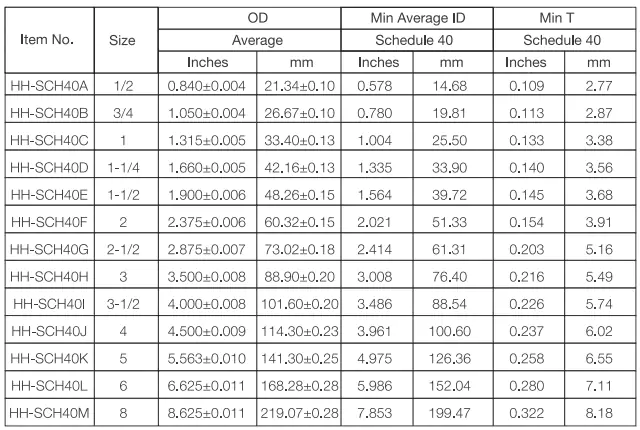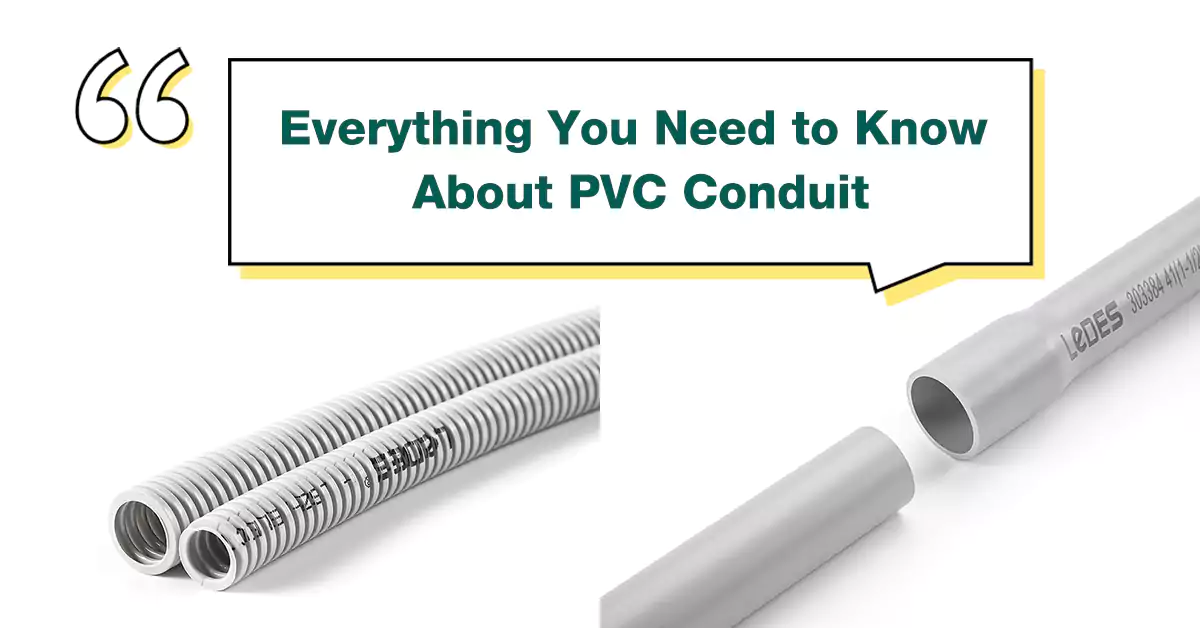
Inhaltsverzeichnis
PVC-Rohre sind ein wichtiger Bestandteil von Elektroinstallationen und bieten Schutz und Ordnung für elektrische Verdrahtungssysteme. Das Verständnis der Eigenschaften, Typen, Installationsmethoden und Anwendungen von PVC-Rohren ist für die Gewährleistung sicherer und effizienter Elektroinstallationen in Wohn-, Gewerbe- und Industrieumgebungen unerlässlich.
Nach der Lektüre dieses Artikels werden Sie wissen:
- Was ist PVC-Rohr und Rohrtypen
- Wo können PVC-Rohre verwendet werden
- Installationsmethoden und -schritte für PVC-Rohre
- So schneiden und verbinden Sie PVC-Rohre richtig
- Ist PVC-Rohr für Hochspannungsanwendungen geeignet?
- Können PVC-Rohre gebogen werden und welche Biegemethoden gibt es?
- Was ist der Unterschied zwischen PVC- und UPVC-Rohren?
- PVC-Rohre vs. Metallrohre
- Was ist der Unterschied zwischen PVC-Rohr und PVC-Leitung
- PVC-Rohr vs. flüssigkeitsdichtes Rohr
- So wählen Sie das richtige PVC-Rohr für Ihr Projekt aus
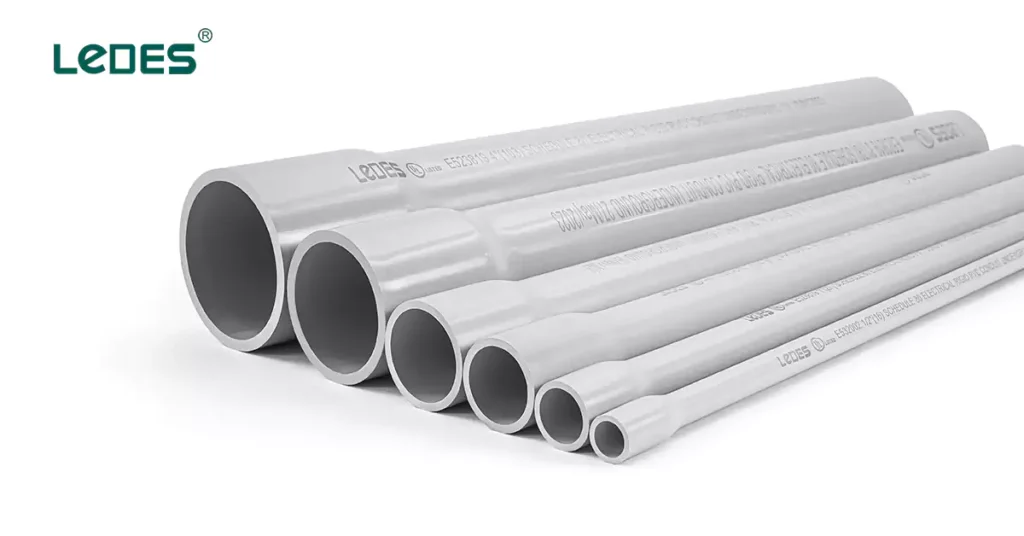
PVC-Rohre, kurz für Polyvinylchlorid-Rohre, sind ein Rohrsystem, das speziell für die Installation elektrischer Leitungen entwickelt wurde. PVC-Rohre werden aus einem langlebigen Kunststoff hergestellt und bieten Schutz für elektrische Kabel vor physischen Schäden und Umwelteinflüssen.
PVC ist ein nichtmetallisches Material, das sowohl leicht als auch korrosionsbeständig ist und sich daher ideal für Innen- und Außeninstallationen eignet. Es leitet keinen Strom und bietet eine zusätzliche Isolierschicht, um die Drähte im Inneren vor elektrischen Gefahren zu schützen. Darüber hinaus ist PVC flexibel genug, um in einer Vielzahl von Situationen eingesetzt zu werden, in denen herkömmliche Metallrohre unpraktisch oder zu schwer sein können.
PVC-Rohre sind in verschiedenen Größen, Stärken und Typen erhältlich, sodass sie für spezifische Projekte angepasst werden können, egal ob für Wohn-, Gewerbe- oder Industrieanwendungen. Sie werden besonders an Orten mit hoher Feuchtigkeit bevorzugt, wie Kellern, Außenanlagen oder unterirdischen Installationen.
Es gibt viele Leitungstypen auf dem Markt. Hier sind 5 Leitungstypen von Ledes. Dies sind die am häufigsten verwendeten Leitungstypen, die Sie kennen sollten:
PVC-Rohr nach UL-Standard, starre PVC-Rohre der Spezifikationen Schedule 40 und Schedule 80 sowie elektrische nichtmetallische Rohre ENT, drei Haupttypen.
Normen: UL651, NEMA TC-2, ASTM D1784-20
Vorteile: Korrosionsbeständig, schlagfest, sonnenlichtbeständig, feuerbeständig, einfach zu installieren.
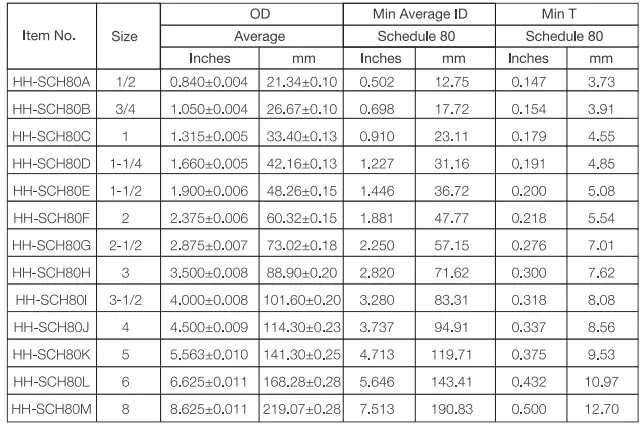
Normen: UL651, NEMA TC-2, ASTM D1784-20
Vorteile: Korrosionsbeständig, schlagfest, feuerbeständig, hohe physikalische Festigkeit, Einsatz unter Tage.
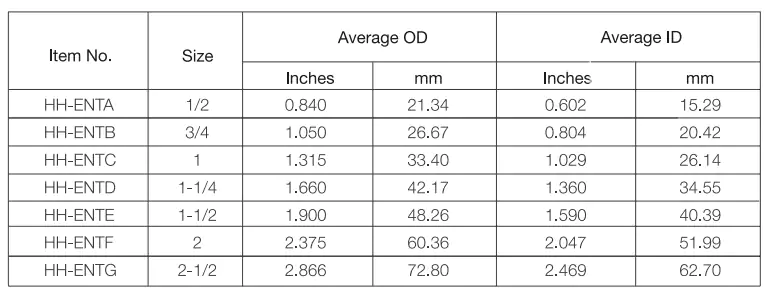
Normen: UL1653
Vorteile: Korrosionsbeständig, schlagfest, sonnenlichtbeständig, feuerbeständig, biegefest, leicht, einfach zu installieren.
Auch in Kanada gibt es drei weit verbreitete Leitungstypen, hier sind die Produktinformationen und Daten von Ledes.
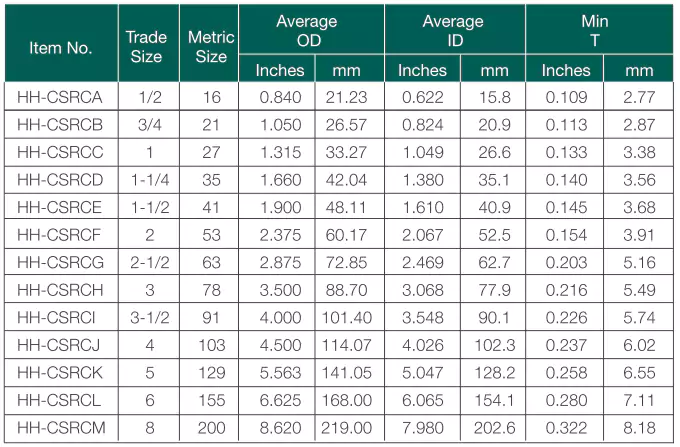
Normen: CSA C22.2 Nr. 211.2
Vorteile: Korrosionsbeständig, schlagfest, sonnenlichtbeständig, feuerbeständig, einfach zu installieren.
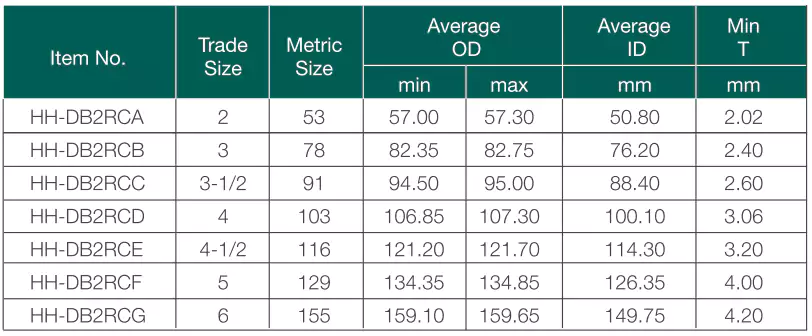
Normen: CSA C22.2 Nr. 211.1
Vorteile: Korrosionsbeständig, schlagfest, sonnenlichtbeständig, feuerbeständig, betondicht, leicht, direkte Vergrabung.
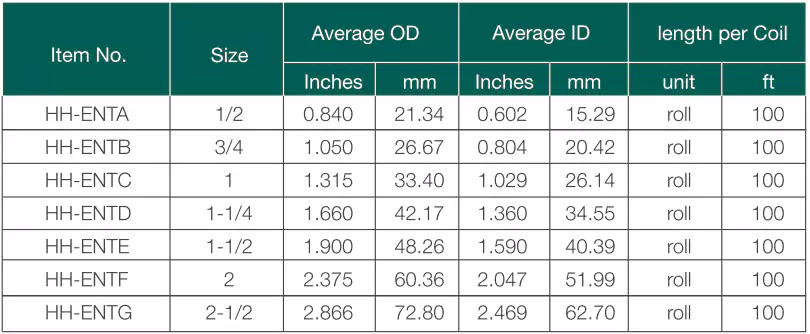
Normen: CSA C22.2 Nr. 211.1
Vorteile: Korrosionsbeständig, schlagfest, sonnenlichtbeständig, feuerbeständig, biegefest, leicht, einfach zu installieren.
Für den australischen und neuseeländischen Markt bietet Ledes mittel- und hochbelastbare Hart-PVC-Rohre sowie mittel- und hochbelastbare Wellrohre für unterschiedliche Bedürfnisse und Anwendungen an.
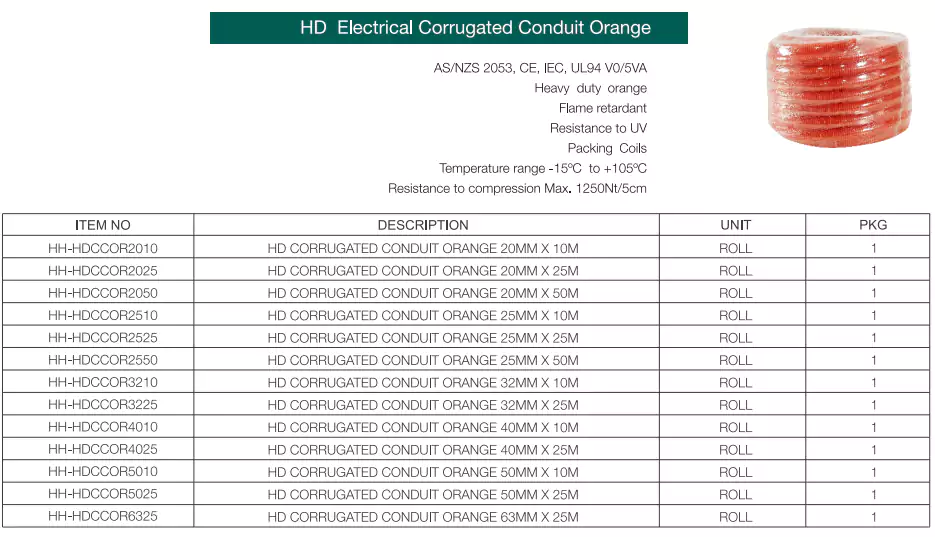
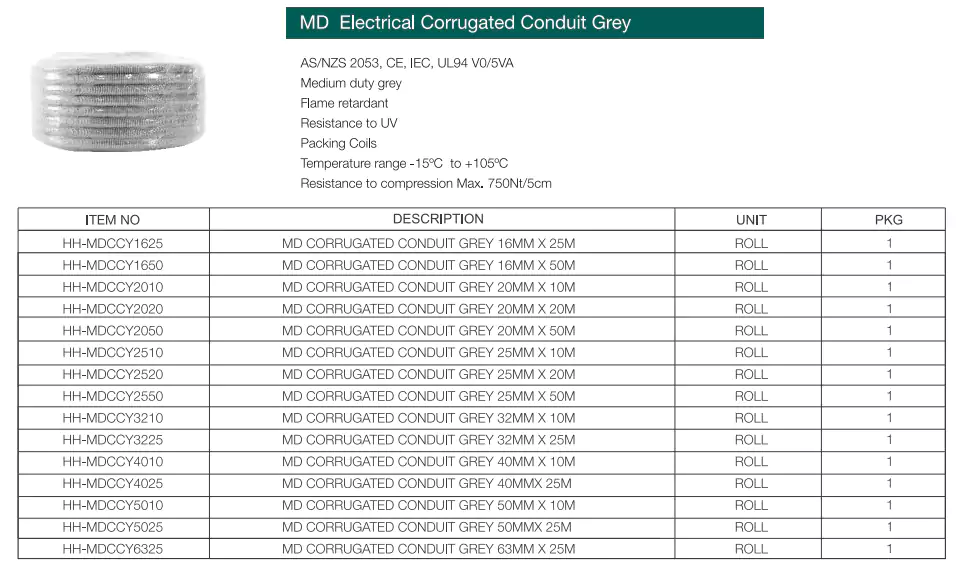
Normen: HD&MD-Wellrohre entsprechen AS/NZS 2053.5, CE, IEC, UL94
Vorteile: Flammhemmend, UV-beständig, hohe Druck- und Schlagfestigkeit, leichtes Gewicht, von Hand biegbar.
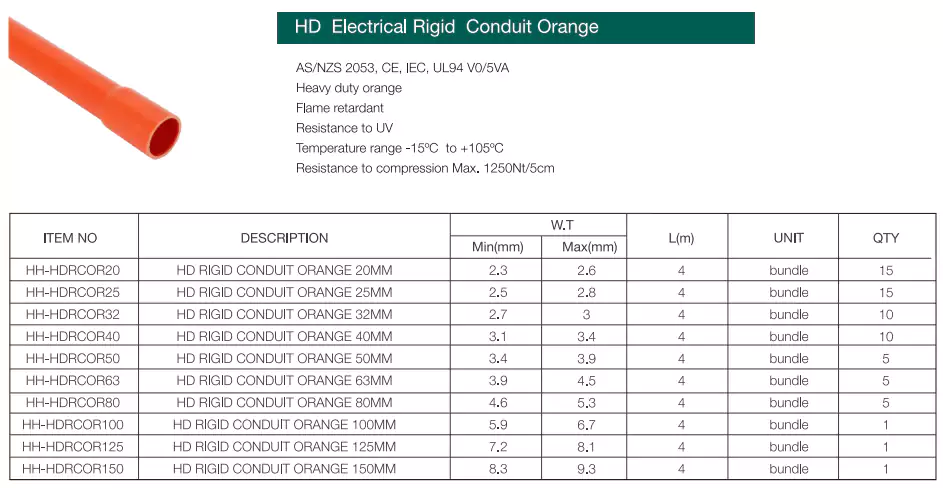
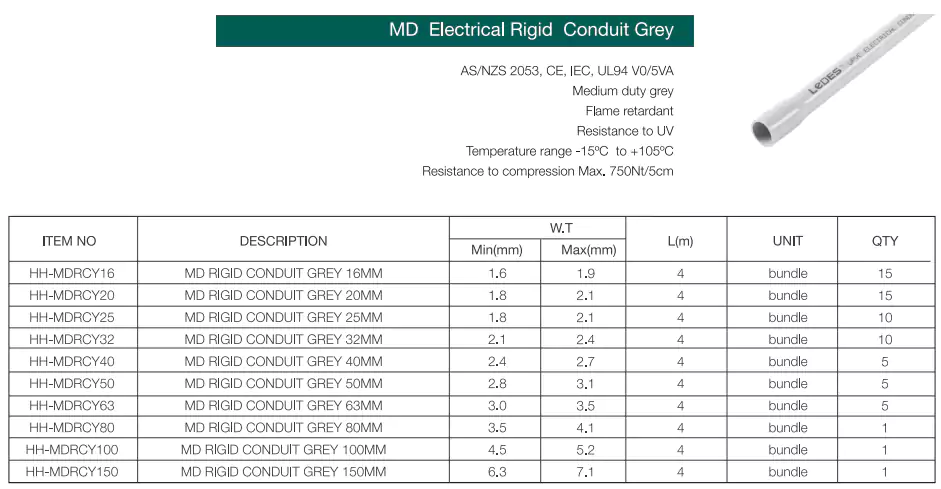
Normen: HD&MD-Hart-PVC-Rohre entsprechen AS/NZS 2053.2, CE, IEC, UL94
Vorteile: Hohe physikalische Festigkeit, flammhemmend, UV-beständig
Solarrohre sind Rohre, die speziell für den Einsatz im Außenbereich entwickelt wurden. Aufgrund der rauen Installationsumgebung sind die Anforderungen an die physikalische Festigkeit und UV-Beständigkeit der Rohre sehr hoch. Hier sind einige gängige Größen und Typen von Ledes.
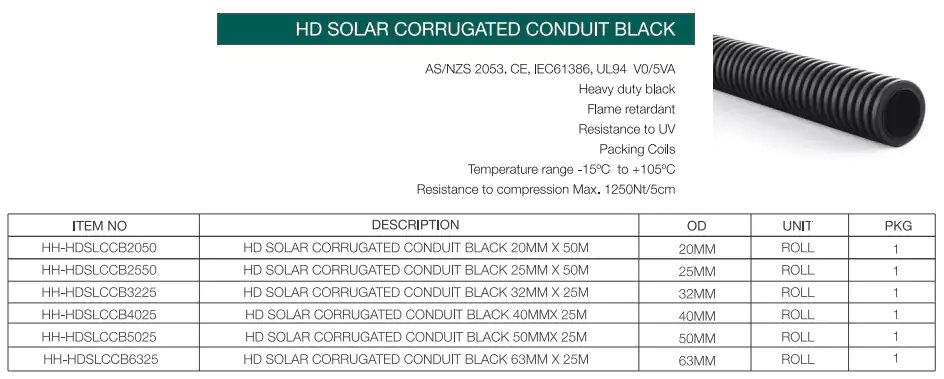
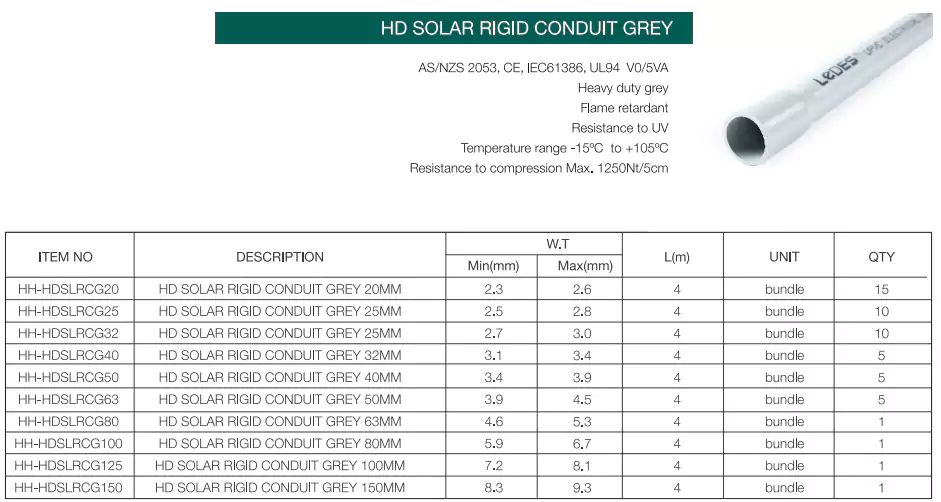
Normen: AS/NZS 2053, CE, IEC
Vorteile: Witterungsbeständig, UV-beständig, schwer entflammbar V0/5VA-zertifiziert, druck- und schlagfest.
Raucharme, halogenfreie Leitungen sind spezielle Leitungen, die so konzipiert sind, dass sie im Brandfall die Freisetzung giftiger Gase und Rauchs minimieren. Mit folgenden Hauptmerkmalen:
Halogenfrei:
Diese Leitungen enthalten keine Halogenelemente wie Chlor, Fluor, Brom oder Jod, die bei der Verbrennung giftige Gase freisetzen können. Diese Eigenschaft erhöht die Sicherheit im Brandfall.
Geringe Rauchentwicklung:
Bei hohen Temperaturen oder Flammen erzeugen halogenfreie Leitungen nur minimalen Rauch. Dies verringert die Sichtprobleme bei einem Brand und ermöglicht eine sicherere Evakuierung und einen einfacheren Zugang für Rettungskräfte.
Ausgezeichnete Feuerbeständigkeit:
Diese Leitungen sind für die Beständigkeit gegen hohe Temperaturen konzipiert und verfügen über ausgezeichnete Feuerbeständigkeitseigenschaften, sodass sie sich für den Einsatz in verschiedenen Anwendungen eignen, darunter öffentliche Gebäude und Industrieanlagen.
Keine giftige Rauchemission:
Im Brandfall geben halogenfreie Leitungen ungiftigen Rauch ab, wodurch das Risiko einer gesundheitsschädlichen Inhalation für Insassen und Rettungskräfte erheblich verringert wird.
UV-beständig:
Diese Leitungen sind so konzipiert, dass sie einer Schädigung durch ultraviolettes (UV-)Licht widerstehen und eignen sich daher für Außenanwendungen, bei denen Sonneneinstrahlung ein Problem darstellt.
Extreme Temperaturbeständigkeit:
Sie widerstehen extremen Temperaturen von -45 °C bis 150 °C, sowohl hohen als auch niedrigen, und gewährleisten so eine zuverlässige Leistung unter unterschiedlichen Umgebungsbedingungen.
Normen: IEC61386, ASTM, UL94
Anwendungen: Krankenhäuser, Schulen, U-Bahnen, überfüllte Orte.
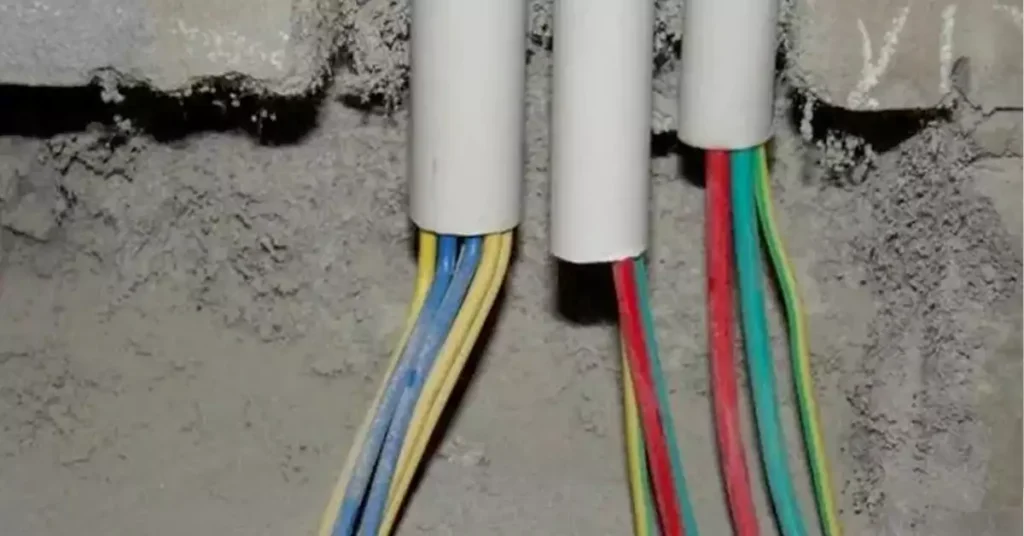
PVC-Rohre sind eine vielseitige Lösung zum Schutz von Elektro- und Kommunikationskabeln in verschiedenen Umgebungen, sowohl ober- als auch unterirdisch. Sie entsprechen den Richtlinien des National Electrical Code (NEC), insbesondere NEC 352, der ihre Verwendung in verschiedenen Umgebungen regelt.
Die PVC-Rohre von Ledes wurden in vielen großen Projekten für den ober- und unterirdischen Einsatz verwendet. Hier sind einige Projektbeispiele.
Beim CHPE-Projekt (Champlain Hudson Power Express) in den USA spielen PVC-Rohre eine entscheidende Rolle bei der Verlegung oberirdischer elektrischer Leitungen. Das Projekt umfasst umfangreiche elektrische Systeme, die sichere und effiziente Verkabelungslösungen erfordern. PVC-Rohre der Klasse 40 werden in Wänden, Decken und anderen Strukturen installiert und bieten einen robusten Schutz vor Umwelteinflüssen und physischen Schäden. Aufgrund ihrer Widerstandsfähigkeit gegenüber direkter Sonneneinstrahlung eignen sie sich für Außeninstallationen und gewährleisten die Langlebigkeit und Zuverlässigkeit der elektrischen Systeme.
Beim Melbourne Metro Tunnel-Projekt in Australien werden für unterirdische Installationen Rohrleitungen verwendet. Das Projekt erfordert umfangreiche Grabungs- und Aushubarbeiten für die elektrische und Kommunikationsinfrastruktur. Raucharme, halogenfreie Rohrleitungen schützen die Verkabelung vor Feuchtigkeit und bodenbedingten Schäden. Diese Anwendung ist besonders in städtischen Umgebungen von Vorteil, in denen der Platz begrenzt ist und eine unterirdische Installation erforderlich ist, um die Zugänglichkeit und Sicherheit der Oberfläche aufrechtzuerhalten.
Der National Electrical Code (NEC) legt spezifische Richtlinien fest, wo PVC-Rohre verwendet werden dürfen und wo nicht. Diese Regeln sind für die Gewährleistung der Sicherheit und Konformität bei elektrischen Installationen von entscheidender Bedeutung.
Gemäß Abschnitt 352.10 in Kapitel 3, NEC, können PVC-Rohre in den folgenden Situationen verwendet werden:
PVC-Rohre sind aufgrund ihrer Haltbarkeit, Korrosionsbeständigkeit und Feuchtigkeitsbeständigkeit für den unterirdischen Einsatz weithin zugelassen. Sie werden häufig in folgenden Bereichen verwendet:
- Direkte Bestattung: PVC-Rohre können direkt im Boden vergraben werden und schützen so die elektrische Leitung vor Schmutz, Feuchtigkeit und möglichen Schäden.
- Unterirdische Kabelkanäle: Wird häufig in gewerblichen und industriellen Umgebungen verwendet, in denen mehrere elektrische Leitungen zum Schutz zusammengefasst werden.
- Der NEC erlaubt die Installation von PVC-Rohren im Außenbereich, vorausgesetzt, sie sind sonnenlichtbeständig. PVC wird häufig verwendet für:
- Außenwände: Solange das PVC-Rohr dem Sonnenlicht ausgesetzt ist, muss es UV-beständig sein, um eine Zersetzung zu verhindern.
- Oberirdische Freiflächenanwendungen: Im Industrie- und Wohnbereich sind PVC-Rohre zulässig, solange sie die entsprechenden Umgebungsspezifikationen erfüllen.
- Da PVC nichtmetallisch sowie wasser- und feuchtigkeitsbeständig ist, eignet es sich optimal für nasse und feuchte Einsatzorte, wie zum Beispiel:
- Keller: Feuchtigkeitsgefährdete Bereiche können von den korrosionsbeständigen Eigenschaften von PVC-Rohren profitieren.
- Industrielle Waschbereiche: Wo elektrische Leitungen häufig Wasser oder Chemikalien ausgesetzt sind, bietet PVC dauerhaften Schutz.
PVC-Rohre sind äußerst chemikalienbeständig und eignen sich daher für Umgebungen, in denen Korrosion Metallrohre beschädigen würde.
Gemäß Abschnitt 352.12 des NEC sind PVC-Rohre jetzt in diesen Situationen zulässig:
PVC-Rohre sind in gefährlichen (klassifizierten) Bereichen, wie z. B. in Bereichen, in denen explosive Gase, Dämpfe oder brennbarer Staub vorhanden sind, nicht zulässig, es sei denn, dies ist in anderen NEC-Artikeln ausdrücklich gestattet. Zu diesen Standorten gehören:
- Erdölraffinerien
- Chemieanlagen
- Getreidesilos
In diesen Umgebungen bietet PVC nicht den notwendigen Schutz vor potenziellen Brand- oder Explosionsgefahren.
PVC-Rohre dürfen nicht zur Unterstützung von Leuchten (Beleuchtungskörpern) oder anderen Geräten verwendet werden, es sei denn, sie sind ausdrücklich für eine solche Verwendung vorgesehen (wie in NEC 352.10(H) beschrieben). Das bedeutet, dass PVC nicht als Strukturelement zur Unterstützung schwerer Leuchten verwendet werden darf.
PVC-Rohre sollten nicht in Bereichen verwendet werden, in denen sie physikalischen Schäden ausgesetzt sein könnten, es sei denn, sie sind ausdrücklich für diesen Einsatzzweck gekennzeichnet. PVC ist im Vergleich zu Metallrohren weniger schlagfest und daher für Bereiche ungeeignet, in denen es geschlagen oder zerdrückt werden könnte, wie beispielsweise:
- Stark frequentierte Industriegebiete
- Bauzonen
PVC-Rohre sind in Umgebungen, in denen die Umgebungstemperatur 50 °C (122 °F) übersteigt, nicht zulässig, es sei denn, sie sind für den Einsatz bei hohen Temperaturen zugelassen. Hohe Hitze kann dazu führen, dass sich PVC verzieht, seine strukturelle Integrität verliert oder eine Brandgefahr darstellt. Zu solchen Umgebungen gehören:
- Heizungskeller
- Bereiche in der Nähe von Industrieöfen
PVC-Rohre dürfen in Theatern und ähnlichen Einrichtungen nicht verwendet werden, es sei denn, dies ist in den Abschnitten 518.4 und 520.5 des NEC ausdrücklich gestattet. In diesen Räumen gelten möglicherweise besondere Brandschutzanforderungen, die PVC nicht erfüllt, wie beispielsweise:
- Leistungsphasen
- Kinos
Wenn Sie wissen, wo PVC-Rohre gemäß NEC zulässig sind und wo nicht, ist eine sichere und konforme Installation gewährleistet.
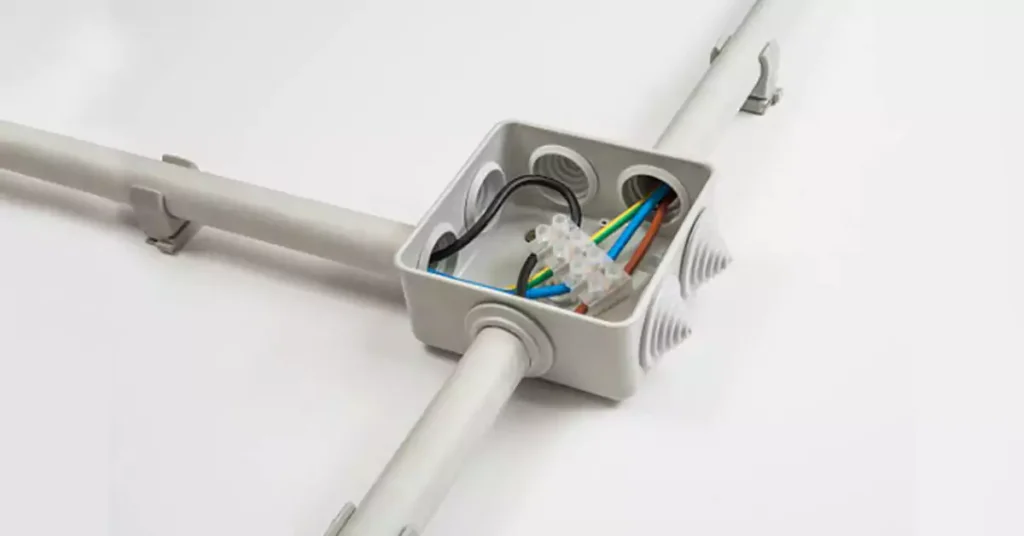
Wir haben bereits ein ausführliches Tutorial geschrieben. Wenn Sie interessiert sind, können Sie Erfahren Sie alles über die Installation von PVC-ElektrorohrenIm Folgenden sind die allgemeinen Installationsschritte aufgeführt:
Untersuchen Sie das Gebiet: Bestimmen Sie den Weg für Ihre Leitungen und berücksichtigen Sie dabei, wo sich Ihre Schaltkästen, Steckdosen oder Schalter befinden werden. Vermeiden Sie unbedingt Bereiche, in denen PVC-Leitungen nicht zulässig sind (z. B. Plenumräume oder Bereiche mit hoher Hitze gemäß NEC-Vorgabe).
Messen Sie den Pfad: Messen Sie die benötigte Länge des Rohrs und markieren Sie die Stellen, an denen Biegungen, Kästen und Abzweigungen erforderlich sind. Beachten Sie die NEC-Anforderungen für den Abstand zwischen Rohrhalterungen und die Positionierung von Abzweigkästen.
Markieren Sie die Schnittstellen: Verwenden Sie ein Maßband und einen Marker, um das PVC-Rohr auf die erforderliche Länge zu messen und zu markieren.
Schneiden Sie das Rohr ab: Für einen sauberen Schnitt verwenden Sie einen PVC-Rohrschneider. Alternativ kann auch eine feinzahnige Metallsäge verwendet werden.
Kanten entgraten: Entgraten Sie nach dem Schneiden die Kanten des Rohrs mit einem Universalmesser oder Schleifpapier. Dieser Schritt ist wichtig, um zu verhindern, dass scharfe Kanten die elektrischen Leitungen während der Installation beschädigen.
Größeren Kanal wählen: Um die Installation zu erleichtern, insbesondere wenn mehrere Kabel verlegt werden, verwenden Sie einen Kabelkanal, der größer ist als die Mindestanforderung von NEC. Dadurch wird die Reibung beim Einziehen der Kabel verringert.
Wählen Sie geeignete Schaltkästen aus: Wählen Sie Boxen, die genügend Platz für Kabelverbindungen bieten, da enge Boxen zu Überhitzung führen können. Stellen Sie sicher, dass die Boxen für den vorgesehenen Standort geeignet sind (z. B. wetterfeste Boxen für den Außenbereich).
Wärmebiegen (falls erforderlich): Für individuelle Biegungen verwenden Sie eine Heißluftpistole, um das PVC-Rohr zu erweichen, und formen es dann vorsichtig. Halten Sie die Biegung an Ort und Stelle, bis sie abgekühlt ist.
Winkelstücke für Kurven: Wenn Sie das Rohr nicht manuell biegen möchten, verwenden Sie PVC-Winkelstücke für 90-Grad- oder andere Winkelbiegungen.
Installieren Sie Anschlusskästen für komplexe Leitungen: Bei Leitungen mit mehreren Biegungen oder beim Übergang zwischen Leitungsabschnitten können Anschlusskästen verwendet werden, um die Verlegung der Leitung zu vereinfachen und einfache Zugangspunkte für die Verkabelung bereitzustellen.
Zement auftragen: Um Abschnitte eines PVC-Rohrs zu verbinden oder das Rohr an Armaturen (Kniestücke, Kupplungen) anzubringen, tragen Sie PVC-Kleber sowohl auf der Innenseite der Armatur als auch auf der Außenseite des Rohrs auf.
Stellen Sie sichere Verbindungen her: Drücken Sie das Rohr in die Armatur und drehen Sie es leicht, um eine starke, wasserdichte Verbindung zu gewährleisten. PVC-Rohre benötigen im Allgemeinen keine Grundierung wie andere PVC-Rohrsysteme.
Verbinden Sie die Leitung mit den Boxen: Befestigen Sie das PVC-Rohr mit geeigneten Armaturen an den Schaltkästen. Stellen Sie sicher, dass die Kästen sicher an Wänden, Decken oder anderen Strukturen montiert sind.
Außenkartons verschließen: Verwenden Sie bei Außeninstallationen wetterfeste Verteilerdosen und tragen Sie Dichtungsmittel um die Leitungseinführungspunkte auf, um das Eindringen von Feuchtigkeit zu verhindern.
Installieren Sie die Kabelaufhänger: Befestigen Sie das PVC-Rohr mit Rohraufhängern oder -bändern an Wänden, Decken oder entlang von Balken. Der NEC empfiehlt, PVC-Rohre in Abständen von höchstens 3 Fuß zu befestigen.
Verankern Sie den Kanal: Befestigen Sie die Rohraufhänger mit Schrauben, Dübeln oder anderen Befestigungsmitteln fest an der Struktur. Stellen Sie sicher, dass das Rohr nicht durchhängt und sicher an seinem Platz bleibt.
Führen Sie das Einziehband durch die Leitung: Führen Sie ein Einziehband in ein Ende des Rohrs ein und schieben Sie es durch, bis es das andere Ende erreicht.
Befestigen Sie Drähte am Einziehband: Befestigen Sie die elektrischen Leitungen mit Isolierband am Einziehband.
Ziehen Sie die Drähte: Ziehen Sie das Einziehband vorsichtig durch das Rohr und nehmen Sie dabei die Drähte mit. Achten Sie darauf, die Drahtisolierung nicht zu beschädigen.
Schützen Sie die Drahtenden: Installieren Sie an den Enden des Kabelkanals, an denen die Drähte austreten, Kabeldurchführungen. Diese Durchführungen schützen die Drähte vor scharfen Kanten an den Kabelkanalenden und verhindern so mögliche Schäden an der Isolierung.
Sichern Sie die Buchsen an ihrem Platz: Stellen Sie sicher, dass die Durchführungen richtig angebracht und gesichert sind, um die Drähte beim Verlassen des Kabelkanals in Schaltkästen oder Gehäuse zu schützen.
Überprüfen Sie alle Verbindungen: Überprüfen Sie nach der Installation des Kabelkanals und dem Verlegen der Kabel, ob alle Kabelverbindungen fest und sicher sind. Stellen Sie sicher, dass alle Armaturen, Kupplungen und Kästen ordnungsgemäß abgedichtet sind.
Kontinuität testen: Prüfen Sie mit einem Multimeter die Verkabelung auf Durchgang und stellen Sie sicher, dass die elektrischen Anschlüsse ordnungsgemäß funktionieren, bevor Sie das System einschalten.
Durch Befolgen dieser detaillierten Schritte können Sie eine sichere, effiziente und konforme Installation von PVC-Rohren für Ihr Elektroverkabelungsprojekt gewährleisten.
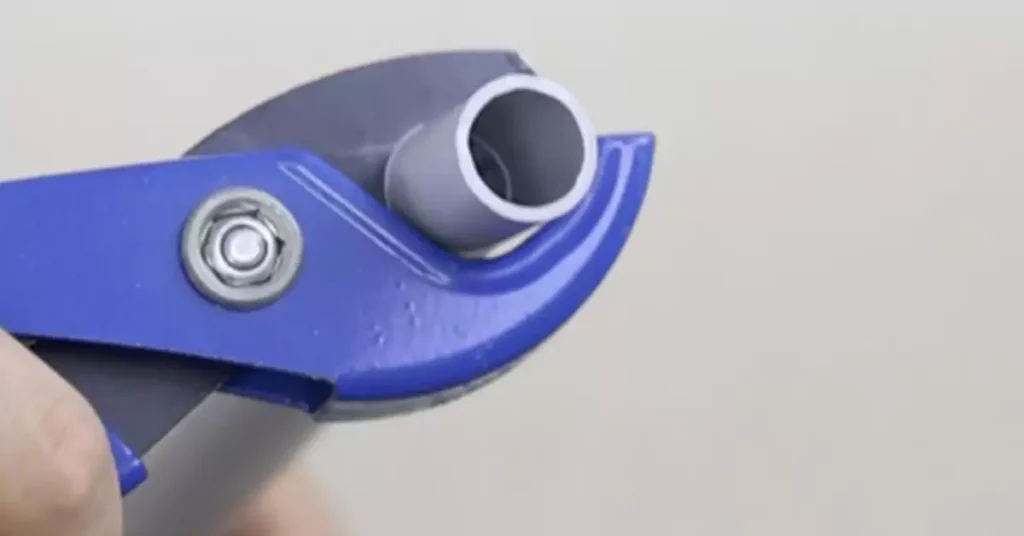
Das korrekte Schneiden und Verbinden von PVC-Rohren ist für eine saubere, effiziente und sichere Elektroinstallation unerlässlich. In diesem Abschnitt führen wir Sie durch die bewährten Vorgehensweisen zum Schneiden von PVC-Rohren und zum Herstellen sicherer Verbindungen mit PVC-Kleber und -Anschlüssen.
Bevor Sie mit dem Schneiden und Verbinden von PVC-Rohren beginnen, legen Sie sich die erforderlichen Werkzeuge zurecht:
PVC-Rohrschneider: Ein PVC-Rohrschneider mit Ratsche ermöglicht saubere, gerade Schnitte bei minimalem Kraftaufwand.
Säge: Wenn Sie keinen PVC-Schneider haben, können Sie das Rohr auch mit einer feinzahnigen Metallsäge schneiden. Dies ist allerdings möglicherweise zeitaufwändiger und mühsamer.
Entgratungswerkzeug oder Universalmesser: Diese Werkzeuge helfen, die rauen Kanten nach dem Schneiden zu glätten.
Maßband und Marker: Wird zum Messen und Markieren des Rohrs zum Schneiden verwendet.
PVC-Kleber: Erforderlich zum sicheren Verbinden von Leitungsabschnitten und Armaturen.
Kupplungen und Armaturen: Zum Verbinden von zwei oder mehr Leitungsabschnitten oder zum Anbringen von Leitungen an Schaltkästen.
Genaue Messung: Messen Sie die erforderliche Länge des Rohrs mit einem Maßband. Messen Sie immer zweimal, um Genauigkeit sicherzustellen, insbesondere wenn das Rohr durch enge Räume verläuft oder bestimmte Abmessungen aufweisen muss.
Markieren Sie den Schnittpunkt: Markieren Sie mit einem Permanentmarker die Stelle, an der das Rohr durchgeschnitten wird. Zeichnen Sie eine Linie um den gesamten Umfang, um einen geraden Schnitt zu gewährleisten.
Verwendung eines PVC-Rohrschneiders: Öffnen Sie die Backen des PVC-Rohrschneiders und positionieren Sie sie um die markierte Linie auf dem Rohr. Üben Sie gleichmäßigen Druck aus, während Sie die Griffe zusammendrücken, um das Rohr zu durchschneiden. Mit diesem Werkzeug erzielen Sie einen sauberen und geraden Schnitt.
Verwendung einer Metallsäge: Wenn Sie eine Metallsäge verwenden, befestigen Sie das Rohr in einem Schraubstock oder an einer stabilen Oberfläche, um es an Ort und Stelle zu halten. Sägen Sie das Rohr mit langsamen, gleichmäßigen Bewegungen durch und achten Sie darauf, der markierten Linie zu folgen, um einen geraden Schnitt zu gewährleisten.
Vermeiden Sie gezackte Kanten: Stellen Sie sicher, dass der Schnitt glatt und gerade ist. Gezackte oder unebene Kanten können das Anschließen des Rohrs erschweren und die Kabelisolierung beschädigen.
Glätten Sie die Innenkante: Nach dem Schneiden weist die Innenseite des Rohrs scharfe Grate auf, die beim Durchziehen möglicherweise elektrische Drähte beschädigen könnten. Verwenden Sie ein Entgratungswerkzeug oder ein Universalmesser, um diese rauen Kanten zu glätten.
Glätten Sie die Außenkante: Wichtig ist auch das Glätten der Außenkanten, um eine saubere Verbindung mit Kupplungen und Armaturen zu gewährleisten.
PVC-Kleber auftragen: Im Gegensatz zu PVC-Rohren, die für Sanitärinstallationen verwendet werden, benötigen PVC-Leitungen normalerweise keine Grundierung. Tragen Sie PVC-Kleber gleichmäßig um die Außenseite des Leitungsendes und die Innenseite der Armatur auf. Verwenden Sie unbedingt PVC-Kleber, der speziell für Elektroleitungen geeignet ist, um eine sichere, dauerhafte Verbindung zu gewährleisten.
Drücken und Drehen: Schieben Sie das Rohr unmittelbar nach dem Auftragen des Klebers in die Armatur und drehen Sie es etwa eine Vierteldrehung, um den Kleber gleichmäßig zu verteilen. Halten Sie Rohr und Armatur einige Sekunden lang zusammen, damit der Kleber aushärten kann.
Zeit einstellen: Lassen Sie den Kleber gemäß den Anweisungen des Herstellers aushärten. Normalerweise härtet PVC-Kleber innerhalb weniger Minuten aus, es kann jedoch bis zu 24 Stunden dauern, bis die Fuge vollständig ausgehärtet ist.
Auf Lücken prüfen: Sobald der Zement ausgehärtet ist, überprüfen Sie die Fugen, um sicherzustellen, dass keine Lücken oder losen Verbindungen vorhanden sind. Die Fugen sollten fest, sicher und richtig ausgerichtet sein.
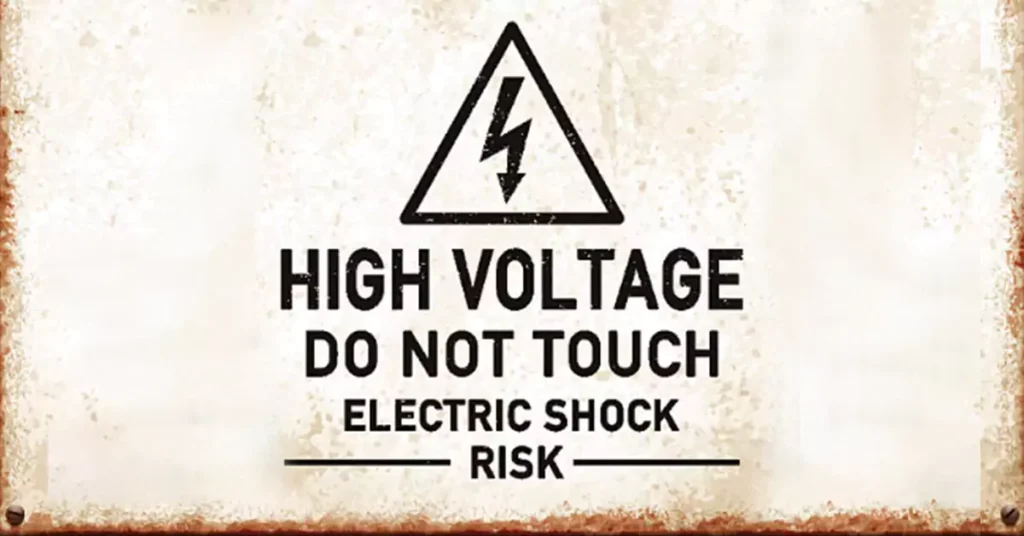
Mit Hochspannung sind typischerweise elektrische Systeme gemeint, die mit Spannungen über 1.000 Volt Wechselstrom oder 1.500 Volt Gleichstrom betrieben werden. PVC-Rohre aus Polyvinylchlorid weisen mehrere Eigenschaften auf, die bei der Verwendung in solchen Anwendungen sowohl vorteilhaft als auch einschränkend sind:
Elektrische Isolierung: PVC ist ein nichtleitendes Material und daher von Natur aus resistent gegenüber elektrischem Strom, was dazu beitragen kann, das Risiko eines Lichtbogens zu verringern.
Flammhemmung: PVC-Rohre verfügen über flammhemmende Eigenschaften, was ein wichtiger Faktor in Hochspannungsumgebungen ist, in denen es zu Hitzestaus und elektrischen Fehlern kommen kann.
Temperatursensitivität: PVC stößt in Umgebungen mit hohen Temperaturen (über 50 °C/122 °F) an seine Grenzen und kann unter extremen Bedingungen weich werden oder sich verziehen, was bei Hochspannungssystemen, bei denen die Wärmeableitung eine entscheidende Rolle spielt, ein Problem darstellen kann.
Der National Electrical Code (NEC) enthält strenge Richtlinien für die Installation von elektrischen Leitungen, einschließlich PVC, in Hochspannungsanwendungen. Gemäß NEC Kapitel 3, Artikel 300 gelten für Hochspannungssysteme aufgrund der potenziellen Gefahren, die mit erhöhtem Strom verbunden sind, strengere Installationsstandards als für Niederspannungssysteme. Einige wichtige Punkte sind:
In diesem Abschnitt wird die Verwendung von starren PVC-Rohren behandelt. Für Hochspannung ist jedoch die Einhaltung bestimmter Bedingungen erforderlich:
Unterirdische Nutzung: PVC-Rohren werden häufig für unterirdische Hochspannungsanwendungen zugelassen, insbesondere bei direkter Verlegung im Erdreich, wo die Rohre die Kabel vor Feuchtigkeit, Erdbewegungen und Korrosion schützen können.
Über der Erde: Obwohl PVC-Rohre für oberirdische Hochspannungssysteme verwendet werden können, müssen sie für diesen Einsatzzweck zugelassen sein und besondere Anforderungen erfüllen, insbesondere im Hinblick auf die Einwirkung von Sonnenlicht und hohen Temperaturen.
NEC-Artikel 300 betont die Bedeutung der Leiterisolierung und -trennung bei Hochspannungsinstallationen. Für Hochspannung ausgelegte Leiter müssen über geeignete Isolationswerte verfügen, um Durchschläge zu verhindern, und PVC-Rohre selbst müssen für den Einsatz mit Hochspannung zugelassen sein, insbesondere wenn sie in Verbindung mit anderen Rohrtypen in gemischten Systemen verwendet werden.
Für Hochspannungsanwendungen legt NEC strenge Grenzwerte für die Füllmenge von Leitungen fest und verlangt eine Reduzierung der Leiterleistung, um Überhitzung zu vermeiden. Das bedeutet, dass PVC-Leitungen die richtige Größe haben müssen, um eine Überschreitung der maximalen Füllmenge zu vermeiden, insbesondere bei Hochspannungsinstallationen, bei denen die Wärmeableitung von entscheidender Bedeutung ist.
Bei langen PVC-Leitungen muss laut NEC die thermische Ausdehnung und Kontraktion berücksichtigt werden. Hochspannungssysteme erzeugen mehr Wärme und die Empfindlichkeit von PVC gegenüber Temperaturschwankungen kann zu Ausdehnung oder Verformung führen. Um diese Bewegung auszugleichen und Schäden an der Leitung oder den Kabeln zu vermeiden, sind möglicherweise Dehnungsverbinder erforderlich.
PVC-Rohre sind für bestimmte Hochspannungsanwendungen geeignet, vorausgesetzt, die Installation erfüllt die NEC-Anforderungen und berücksichtigt die Einschränkungen des Materials. Hier sind einige Szenarien, in denen PVC-Rohre häufig für Hochspannung verwendet werden:
PVC-Rohre werden häufig für die unterirdische Hochspannungsverteilung verwendet, insbesondere in Industrieanlagen, Umspannwerken oder Versorgungsleitungen. Aufgrund ihrer Feuchtigkeits- und Korrosionsbeständigkeit eignen sie sich ideal zum Schutz von Hochspannungskabeln in unterirdischen Anwendungen.
In Umgebungen, in denen das Rohr Wasser oder Chemikalien ausgesetzt sein könnte, bietet PVC im Vergleich zu Metallrohren eine hervorragende Korrosionsbeständigkeit. Dadurch eignet es sich für Hochspannungsinstallationen im Außenbereich oder in der Industrie, wie z. B. in Kläranlagen oder Küstenregionen.
PVC-Rohre werden häufig in Systemen für erneuerbare Energien wie Solar- oder Windparks verwendet, wo Hochspannungskabel unter der Erde oder in Umgebungen, die den Elementen ausgesetzt sind, geschützt werden müssen.
Trotz seiner Vorteile ist ein PVC-Rohr nicht für alle Hochspannungsanwendungen geeignet, insbesondere in Situationen, in denen seine physikalischen oder chemischen Einschränkungen überschritten werden:
Hochtemperaturanwendungen
Gefahrenbereiche
Bereiche mit hoher körperlicher Belastung
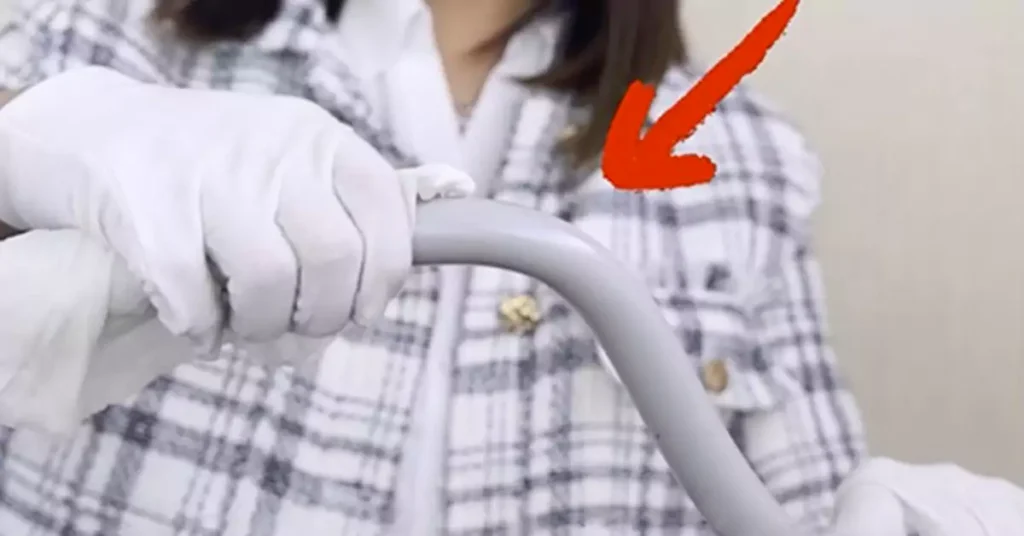
Ja, PVC-Rohre können gebogen werden, um während der Installation verschiedene Winkel und Richtungsänderungen zu ermöglichen. Es gibt zwei gängige Methoden zum Biegen von PVC-Rohren: die Verwendung einer Heißluftpistole oder eines Rohrbiegers mit einem für PVC entwickelten Heizelement.
- Bereiten Sie den Kanal vor: Messen und markieren Sie die Stelle, an der die Biegung erfolgen muss. Sichern Sie das Rohr an Ort und Stelle, um Bewegungen während des Biegens zu verhindern.
- Erhitzen Sie die Leitung: Verwenden Sie eine Heißluftpistole, um den Abschnitt des Rohrs, den Sie biegen möchten, gleichmäßig zu erhitzen. Bewegen Sie die Heißluftpistole hin und her, um eine Hitzekonzentration an einer Stelle zu vermeiden, da das PVC sonst Blasen bilden oder verbrennen könnte. Erhitzen Sie das PVC, bis es flexibel wird, normalerweise auf etwa 82 °C.
- Biegen Sie das Rohr: Sobald das PVC flexibel ist, biegen Sie es vorsichtig mit der Hand in den gewünschten Winkel. Sie können eine Biegevorrichtung oder Form verwenden, um eine gleichmäßige Biegung beizubehalten. Halten Sie die Biegung an Ort und Stelle, bis das PVC abkühlt und aushärtet.
- Abkühlen und die Biegung prüfen: Nachdem das Rohr abgekühlt ist (was normalerweise ein paar Minuten dauert), überprüfen Sie, ob die Biegung glatt ist und stellen Sie sicher, dass das Innere nicht geknickt oder verstopft ist, da dies die Kabel beschädigen oder gegen die Vorschriften verstoßen könnte.
- Verwenden Sie einen beheizten Bieger: Es sind spezielle PVC-Rohrbieger erhältlich, die das Rohr gleichmäßig erhitzen und präzise Biegungen ermöglichen. Diese Bieger verfügen über ein Heizelement zum Erweichen des PVC und integrierte Führungen zum Biegen in exakten Winkeln.
- Biegen Sie das Rohr: Nachdem das Rohr erhitzt wurde, verwenden Sie den Bieger, um die gewünschte Biegung zu erzeugen. Diese Methode gewährleistet gleichmäßige Biegungen, insbesondere bei größeren Projekten mit mehreren Biegungen in unterschiedlichen Winkeln.
Überhitzung vermeiden: Wenn Sie zu viel Hitze anwenden oder die Heißluftpistole zu nahe halten, kann das PVC Blasen bilden oder verbrennen. Halten Sie die Heißluftpistole in Bewegung und halten Sie einen Sicherheitsabstand ein, um die Hitze gleichmäßig zu verteilen.
Verwenden Sie Handschuhe und Schutzausrüstung: Erhitztes PVC kann sehr heiß werden. Daher ist es wichtig, beim Umgang mit dem Rohr hitzebeständige Handschuhe zu tragen. Stellen Sie außerdem sicher, dass Sie in einem gut belüfteten Bereich arbeiten, da beim Erhitzen von PVC Dämpfe freigesetzt werden können.
Knicke vermeiden: Biegen Sie das Rohr immer langsam und gleichmäßig, um ein Knicken zu vermeiden. Ein geknicktes Rohr kann die elektrischen Leitungen beschädigen oder den Innenraum verengen, sodass es schwierig wird, Kabel hindurchzuziehen.
Auf Verformung prüfen: Überprüfen Sie nach Abschluss der Biegung das Rohr, um sicherzustellen, dass es nicht übermäßig abgeflacht oder verformt ist. Der Innendurchmesser muss frei bleiben, um den elektrischen Vorschriften zu entsprechen.
Berücksichtigen Sie Expansion und Kontraktion: PVC kann sich aufgrund von Temperaturschwankungen ausdehnen oder zusammenziehen. Berücksichtigen Sie dies daher bei der Planung von Biegungen, insbesondere bei langen Leitungsstrecken. Die Verwendung von Dehnungsfugen kann helfen, Probleme zu vermeiden.
PVC- (Polyvinylchlorid) und UPVC- (weichmacherfreies Polyvinylchlorid) Rohre werden beide häufig für Elektroinstallationen verwendet, unterscheiden sich jedoch in Bezug auf Flexibilität, Festigkeit und Anwendung. Hier ist eine Aufschlüsselung der wichtigsten Unterschiede:
Merkmale | PVC-Rohr | UPVC-Rohr |
Stärke und Haltbarkeit | Weniger schlagfest, für leichtere Anwendungen geeignet | Hohe Schlagfestigkeit, langlebig für raue Umgebungen |
Thermischer Widerstand | Geringere Beständigkeit gegenüber hohen Temperaturen | Höhere Hitzebeständigkeit, geeignet für heiße Umgebungen |
Chemische Resistenz |
Gut, aber weniger als UPVC | Hervorragend, beständiger gegen Chemikalien und Korrosion |
Typische Anwendungen | Innenverkabelung, Wohnbereich, leichte Gewerbe | Außenanlagen, Industrieanlagen, unterirdische Anlagen |
Kosten | Niedrigere Kosten, erschwinglicher für den allgemeinen Gebrauch | Höhere Kosten aufgrund erhöhter Haltbarkeit und Festigkeit |
Bei Elektroinstallationen ist die Wahl des Leitungsmaterials entscheidend für die Gewährleistung von Sicherheit, Haltbarkeit und Einhaltung der örtlichen Vorschriften. Zwei gängige Leitungstypen sind PVC-Leitungen (Polyvinylchlorid) und Metallleitungen (wie EMT, RMC und IMC). Jeder Typ hat seine Vor- und Nachteile und eignet sich daher für unterschiedliche Anwendungen.
Merkmale | PVC-Schläuche | Metallische Leitungen |
Material | Kunststoff (Polyvinylchlorid) | Metall (Stahl, Aluminium) |
Gewicht | Leicht | Schwerer |
Kosten | Generell geringere Kosten | Normalerweise höhere Kosten |
Korrosionsbeständigkeit | Ausgezeichnete Beständigkeit | Anfällig für Korrosion |
Flexibilität | Flexibler und einfacher zu installieren | Starr, weniger flexibel |
Feuerbeständigkeit | Gut, aber nicht feuerfest | Bessere Feuerbeständigkeit |
Elektrische Leitfähigkeit | Nicht leitend | Leitfähig |
Schlagfestigkeit | Mäßig | Hoch |
UV-Beständigkeit | Begrenzt (kann im Freien abgebaut werden) | Exzellent |
Anwendung | Innenbereich, Nassräume | Innen- und Außeneinsatz, industrielle Anwendungen |
Wir haben die Unterschiede zwischen PVC-Sanitärrohren und PVC-Leitungen im Detail verglichen. Einzelheiten finden Sie im Artikel Der Unterschied zwischen PVC-Sanitärleitungen und PVC-Elektroleitungen. Hier sind einige wichtige Unterschiede zwischen ihnen.
Merkmale | PVC-Rohr | PVC-Rohr |
Primäre Verwendung | Sanitär- und Abwasserinstallation | Schutz elektrischer Leitungen |
Materialzusammensetzung | Standard-PVC | Hart-PVC mit Zusätzen zur Festigkeitssteigerung |
Wandstärke | Dünnere Wände, leichter | Dickere Wände, schwerer |
Temperaturbereich | Geringere Temperaturtoleranz | Höhere Temperaturtoleranz |
Nennwasserdruck | Hohe Druckanforderungen | Keine besonderen Anforderungen |
Zulassungsnormen | Variiert je nach Anwendung | Muss die elektrischen Vorschriften erfüllen |
Kosten | Im Allgemeinen weniger teuer | Generell teurer |
Materialzusammensetzung: PVC-Rohre werden mit zusätzlichen Zusatzstoffen hergestellt, um ihre Haltbarkeit und Widerstandsfähigkeit gegenüber Umwelteinflüssen zu verbessern. Dies führt zu höheren Materialkosten.
Wandstärke: Die dickeren Wände von PVC-Rohren bieten einen besseren Schutz für die elektrische Verkabelung, was jedoch die Herstellungskosten erhöht.
Normen und Prüfungen: PVC-Rohre müssen strenge elektrische Vorschriften und Standards erfüllen, die zusätzliche Tests und Qualitätssicherung während der Produktion erfordern, was zu höheren Kosten führt.
Marktnachfrage: Die Nachfrage nach Elektroinstallationsrohren im Bauwesen und in der Industrie kann die Preise im Vergleich zu herkömmlichen PVC-Rohren in die Höhe treiben.
Installationskosten: Obwohl es sich nicht um einen direkten Kostenfaktor für das Leitungssystem selbst handelt, kann der Installationsvorgang aufgrund der erforderlichen Spezialanschlüsse und der Einhaltung von Sicherheitsvorschriften ebenfalls zu den Gesamtkosten beitragen.
Als Hersteller sind wir der Meinung, dass der größte Faktor, der den Preis von PVC-Rohren und PVC-Leitungen beeinflusst, der Preis der PVC-Rohstoffe und -Zusätze ist. Im Wesentlichen gibt es zwischen den beiden keinen großen Unterschied, aber die Anwendung ist unterschiedlich.
Zwei gängige Arten von Leitungen sind PVC-Leitungen (Polyvinylchlorid) und flüssigkeitsdichte Leitungen. Jede hat ihre eigenen Eigenschaften, Vorteile und Anwendungen.
PVC-Rohr: Dies ist eine Art starres Rohr aus Polyvinylchlorid, einem leichten und langlebigen Kunststoff. Es wird häufig in Wohn- und Gewerbeanwendungen zum Schutz elektrischer Leitungen verwendet. PVC-Rohre sind feuchtigkeits-, chemikalien- und korrosionsbeständig und daher für verschiedene Umgebungsbedingungen geeignet.
Flüssigkeitsdichte Leitung: Dieses Rohr ist als flexibles und wasserdichtes Gehäuse für elektrische Leitungen konzipiert. Es besteht normalerweise aus flexiblem PVC oder Metall mit einer flüssigkeitsdichten Abdichtung, sodass es an nassen oder feuchten Orten verwendet werden kann. Flüssigkeitsdichte Rohre sind ideal für Anwendungen, bei denen Bewegung oder Vibration auftreten, da sie gebogen werden können, ohne zu brechen.
Besonderheit | PVC-Rohr | Flüssigkeitsdichte Leitung |
Material | Hart-PVC | Flexibles PVC oder Metall |
Flexibilität | Starr | Flexibel |
Wasserbeständigkeit | Gut (nicht für stehendes Wasser geeignet) | Ausgezeichnet (wasserdicht) |
Installation | Erfordert Kleber oder Beschläge | Kann ohne Klebstoff installiert werden |
Anwendungen | Innen und außen (keine Nassbereiche) | Nasse oder feuchte Orte, Maschinenbereiche |
Kosten | Im Allgemeinen niedriger | Höher durch Flexibilität und Abdichtung |
Haltbarkeit | Beständig gegen Chemikalien und Korrosion | Hohe Strapazierfähigkeit, resistent gegen Feuchtigkeit |
Temperaturbereich | Mäßig, normalerweise bis zu 60 °C (140 °F) | Höhere Temperaturbeständigkeit verfügbar |
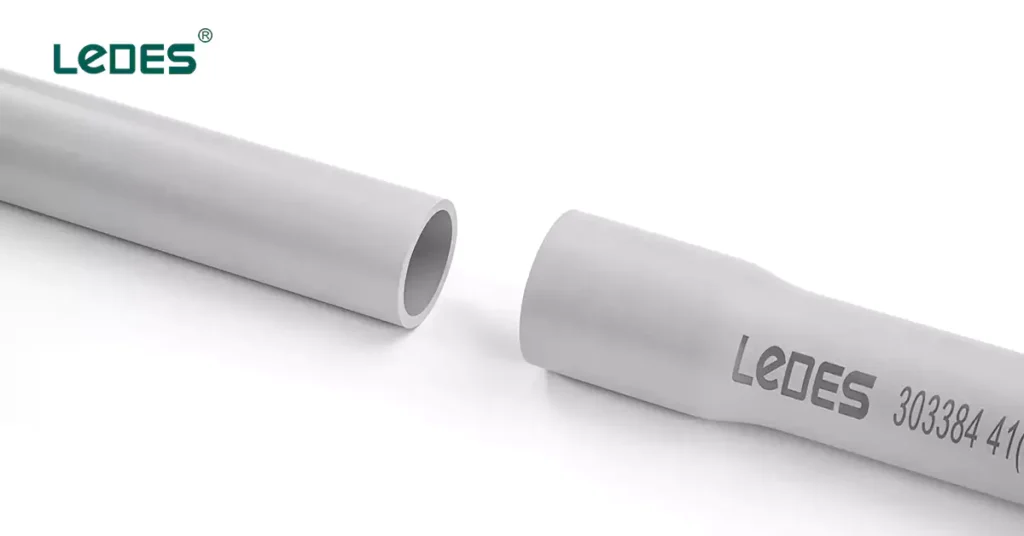
Bei der Auswahl des richtigen PVC-Rohrs für Ihr Projekt müssen mehrere Überlegungen angestellt werden, um Sicherheit, Konformität und Effizienz zu gewährleisten. Hier sind die wichtigsten Faktoren, die Sie berücksichtigen sollten:
Hart-PVC-Rohr: Langlebig und für unterirdische oder freiliegende Installationen geeignet.
Flexibles PVC-Rohr: Ideal für Anwendungen, die Biegen oder Bewegung erfordern.
Anhang 40 vs. Anhang 80: Schedule 80 ist dicker und robuster und für rauere Umgebungen geeignet.
Drinnen vs. Draußen: Für den Außenbereich sollten Rohre UV-beständig sein. Für den Innenbereich gelten möglicherweise andere Anforderungen.
Feuchtigkeit und chemische Belastung: Verwenden Sie bei Bedarf Feuchtraum- oder chemikalienbeständige Leitungen.
Durchmesser: Wählen Sie eine Kabelkanalgröße, die der Anzahl und Größe der zu verlegenden Kabel entspricht. Beachten Sie die NEC-Richtlinien (National Electrical Code) für die Füllkapazität.
Länge: Stellen Sie sicher, dass Sie für Ihre Installation über eine ausreichende Leitungslänge ohne übermäßige Verbindungsstellen verfügen.
Machen Sie sich mit den örtlichen Bauvorschriften und dem NEC vertraut, um die Einhaltung der Sicherheitsbestimmungen sicherzustellen.
Kurven und Wendungen: Überlegen Sie, wie viele Biegungen Ihre Installation erfordert. Für enge Räume sind flexible Leitungen möglicherweise besser geeignet.
Unterstützung und Montage: Stellen Sie sicher, dass Sie über die erforderlichen Halterungen für die Installation Ihrer Leitungen verfügen.
Vergleichen Sie die Kosten verschiedener Typen und Marken von PVC-Rohren. Stellen Sie sicher, dass das Produkt in Ihrer Region leicht erhältlich ist.
Wenn Sie unsicher sind, kann die Beratung durch einen Elektriker oder einen Fachmann Erkenntnisse liefern, die speziell auf die Anforderungen Ihres Projekts zugeschnitten sind.
Zusammenfassend lässt sich sagen, dass PVC-Rohre ein wesentlicher Bestandteil von Elektro- und Bauanwendungen sind und eine Kombination aus Haltbarkeit, Flexibilität und Kosteneffizienz bieten. Aufgrund ihrer Beständigkeit gegen Feuchtigkeit, Chemikalien und Korrosion sind sie die ideale Wahl für Installationen im Innen- und Außenbereich. Egal, ob Sie ein professioneller Bauunternehmer oder ein Heimwerker sind, das Verständnis der verschiedenen Arten von PVC-Rohren und ihrer Anwendungen kann die Sicherheit und Effizienz Ihrer Projekte verbessern.
Indem Sie Faktoren wie Installationsmethoden, lokale Bauvorschriften und Umweltbedingungen berücksichtigen, können Sie fundierte Entscheidungen treffen, die die Vorteile der Verwendung von PVC-Rohren maximieren. Da die Nachfrage nach nachhaltigen und zuverlässigen elektrischen Systemen weiter steigt, bleiben PVC-Rohren eine praktische Lösung, die modernen Anforderungen gerecht wird und gleichzeitig die Einhaltung von Industriestandards gewährleistet. Die Verwendung dieses vielseitigen Materials verbessert nicht nur die Langlebigkeit Ihrer Installationen, sondern trägt auch zu einer sichereren und besser organisierten elektrischen Infrastruktur bei.



